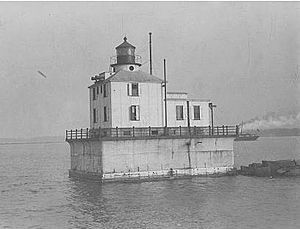Ashtabula Harbor Light facts for kids
 |
|
| Ashtabula Harbor Light before extension of breakwater | |
|
|
|
| Location | Ashtabula Harbor, Lake Erie, Ashtabula, Ohio |
|---|---|
| Coordinates | 41°55′07″N 80°47′45″W / 41.9186°N 80.7959°W |
| Year first lit | 1905 |
| Automated | 1973 |
| Foundation | Concrete crib |
| Construction | Steel/Iron plate |
| Tower shape | rectangular house with central cylindrical tower |
| Markings / pattern | white, red roof & parapet, green trim |
| Height | 40 feet (12 m) |
| Focal height | 51 feet (16 m) |
| Original lens | Fourth Fresnel lens |
| Range | 7.8 nautical miles; 14 kilometres (9 mi) |
| Characteristic | 6 sec Yellow flashing |
| ARLHS number | USA-020 |
| USCG number | 7-3745 |
The Ashtabula Harbor Light is a famous lighthouse in Ashtabula, Ohio. People also call it the Ashtabula Light. It was added to the National Register of Historic Places on August 8, 1983.
Contents
History of the Ashtabula Light
The Ashtabula Harbor Light has a long and interesting history. It has changed locations and designs over the years. Each change helped it better guide ships into the harbor.
Early Lighthouses (1836-1905)
The very first lighthouse in Ashtabula was built in 1836. It was a short, six-sided wooden tower. It stood on a wooden base near the eastern pier. This early light used oil lamps, which were common back then.
Later, a new lighthouse was built on the west pier. This one was shaped like a pyramid. It had a special lens called a Fresnel lens that showed a red light. Lighthouse keepers lived in a house in town. This tower was moved in 1882 but kept working.
The Current Lighthouse (1905-Today)
In 1905, the Ashtabula River mouth was made wider. A long wall, called a breakwater, was also built. These changes led to the building of the lighthouse you see today.
The lighthouse was first placed about 1,750 feet from its current spot. In 1915, it was moved and made bigger. It now sits on a concrete base at the end of the north breakwater. This new building is made of strong steel and iron. It even had living spaces for the lighthouse keepers. A new Fresnel lens was also put in the tower.
Challenges and Changes
The lighthouse's exposed spot made it face many challenges. In 1927, a steamship hit it, moving it six inches off its base. A more famous event happened the next year. A huge ice storm completely covered the lighthouse. The keepers were trapped inside for two days. They had to melt the front door open. Then, they tunneled through five feet of ice to get out!
The Ashtabula Harbor Light was the last lighthouse on the Great Lakes to have keepers living in it. It became automated in 1973. This means machines took over the work of the keepers.
The original keeper's house was given to the city in 1973. But it went back to federal ownership in 1976. This happened because there wasn't enough money to turn it into a museum. In 1982, the building became privately owned. It opened as the Ashtabula Marine Museum in 1984.
The lighthouse itself kept working. The breakwater was even extended past it. In 1995, the old Fresnel lens was replaced with a modern light. The original lens was then given to the museum.
Lens Restoration
A man named Jim Woodward from Cleveland restored the old Fresnel lens. He is one of only four people in the U.S. who can properly repair these special lenses. He learned his skills by training with an expert from the old United States Lighthouse Service.
Future of the Lighthouse
In 2003, a group was formed to take care of the lighthouse. They wanted to own it under the National Historic Lighthouse Preservation Act. They applied for the lighthouse in 2004. In 2007, they officially took control of it.
The group started working to restore the lighthouse. Their goal is to offer public tours. In May 2008, they received money to build a floating dock. This dock is important because the only way to reach the lighthouse is by water. The society has successfully acquired the light.


